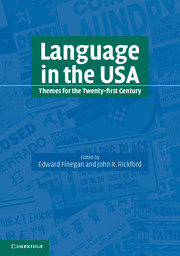Book contents
- Frontmatter
- Contents
- List of figures
- List of tables
- List of contributors
- Acknowledgments
- Foreword
- Editors' preface
- Part 1 American English
- Part 2 Other language varieties
- Part 3 The sociolinguistic situation
- 15 Language ideology and language prejudice
- 16 Ebonics and its controversy
- 17 Language planning, language policy, and the English-Only Movement
- 18 Language in education
- 19 Adolescent language
- 20 Slang
- 21 Hip Hop Nation Language
- 22 Language, gender, and sexuality
- 23 Linguistic identity and community in American literature
- 24 The language of doctors and patients
- 25 The language of cyberspace
- 26 Language attitudes to speech
- Index
25 - The language of cyberspace
Published online by Cambridge University Press: 05 June 2012
- Frontmatter
- Contents
- List of figures
- List of tables
- List of contributors
- Acknowledgments
- Foreword
- Editors' preface
- Part 1 American English
- Part 2 Other language varieties
- Part 3 The sociolinguistic situation
- 15 Language ideology and language prejudice
- 16 Ebonics and its controversy
- 17 Language planning, language policy, and the English-Only Movement
- 18 Language in education
- 19 Adolescent language
- 20 Slang
- 21 Hip Hop Nation Language
- 22 Language, gender, and sexuality
- 23 Linguistic identity and community in American literature
- 24 The language of doctors and patients
- 25 The language of cyberspace
- 26 Language attitudes to speech
- Index
Summary
Editors' introduction
Like a few chapters in this volume, this one could not have appeared in the earlier edition of Language in the USA. When Denise E. Murray started her research into the language of cyberspace in 1984, the World Wide Web did not exist. Now many people, especially younger ones, can hardly imagine life without “the web.” In just a couple of decades, computer-mediated communication (CMC) has developed characteristic uses and characteristic linguistic features, as well as a “netiquette” of e-interaction. So prevalent and so important has computer-mediated language become – and of such excitement to so many people (though not to everyone) – that a book treating language in the USA but lacking a chapter on this topic would disappoint many student readers and their teachers.
The basic question this chapter asks is what effects the new form of communication has had on language and language use, and Murray tackles the question from three perspectives: Which new communicative situations does CMC enable and foster? Which metaphors do we use in our discussions about CMC and its venues – and what effect do those metaphors have on our perceptions and judgments about CMC? What is the place – now and in the future – of English in cyberspace? While the discussion of how CMC has affected English and other languages will interest many of you because of your familiarity or fascination with CMC, the processes influencing the formation of new words and practices in CMC are subject to the same general principles that influence language use and language change in other domains and that are discussed in the other chapters of this volume.
- Type
- Chapter
- Information
- Language in the USAThemes for the Twenty-first Century, pp. 463 - 479Publisher: Cambridge University PressPrint publication year: 2004
- 2
- Cited by

